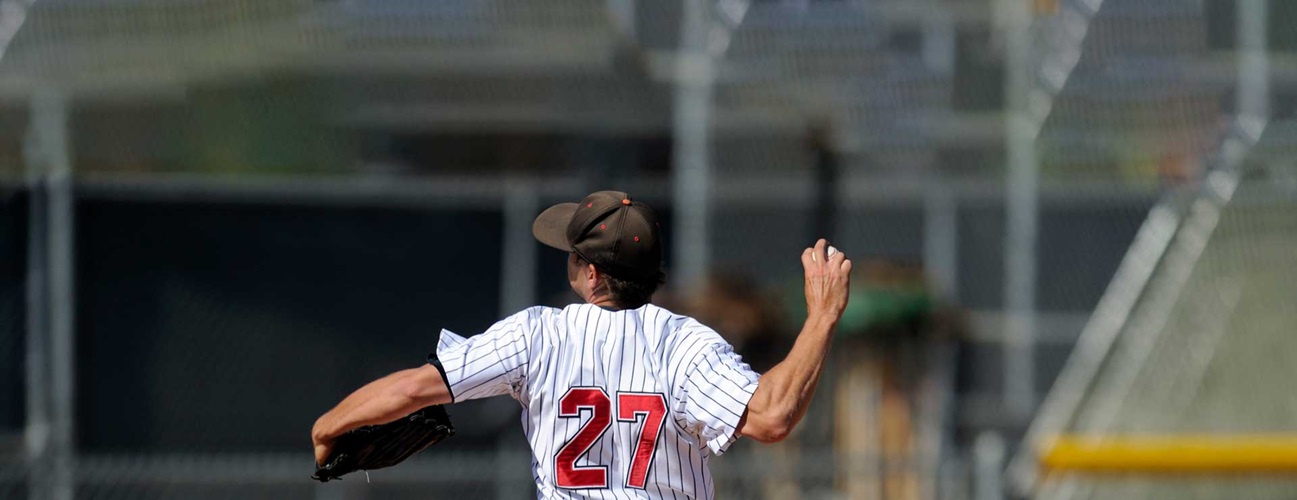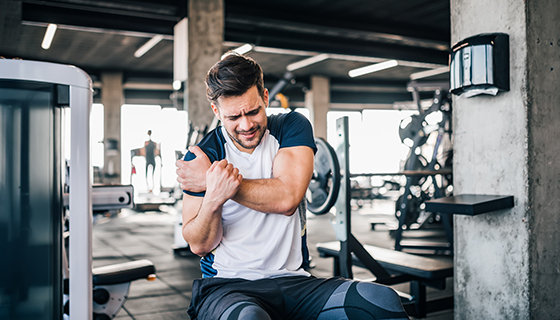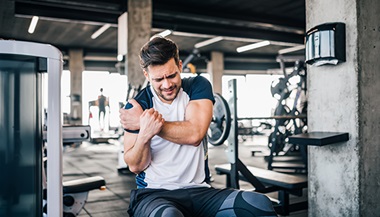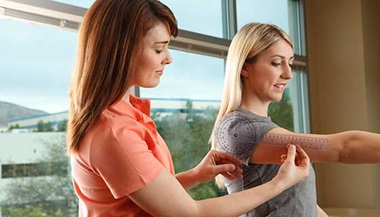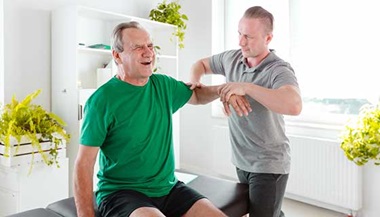Baseball-Related Shoulder Injuries
What You Need to Know
- Throwing pain is mostly associated with inflamed rotator cuff tendons, shoulder instability and/or labrum tears.
- It is difficult to diagnose the cause of throwing pain in athletes and determine the stability of the shoulder. A physical examination should be done to evaluate the shoulder, but an MRI or arthroscopy of the shoulder may also be ordered.
- Treatment options vary for baseball-related shoulder injuries depending on the type and severity of the condition and range from non-operative treatments to surgical procedures.
What are common symptoms of shoulder problems in throwers?
The most common symptom among baseball players who throw is pain and often a decrease in performance, such as a decrease in velocity. Occasionally a player may feel as if their shoulder feels loose or is coming out of the socket, but usually the problem is pain during or after throwing.
5 Tips for Preventing Sports-Related Injuries

Many sports injuries result from pushing our bodies past our current physical limits or level of conditioning.
Follow these five tips from sports medicine expert Dr. Andrew Cosgarea to avoid getting hurt.What causes throwing pain?
Pain after throwing is typical of inflamed rotator cuff tendons. Basically the shoulder is inflamed or irritated after throwing. The exact cause of the pain is not known, although there are several theories about it.
The first possibility is that the tendons are seeing too much stress. This usually occurs when someone tries to get into shape too fast over too short of a period of time. The shoulder and rotator cuff tendons do not like large increases in stress whether it is early in the season or late in the season. Usually when the arm has just seen too much stress, recovery can be achieved with the usual treatments. This includes cutting back on throwing for a brief period, using ice after throwing or even a few times a day, anti-inflammatory medications and rehabilitation exercises. The rotator cuff exercises should initially be done below shoulder level and progressed to above shoulder level slowly. If the exercises hurt, then you are either doing them wrong or your body is telling you something. When the cause of the pain is overuse, it seems that the recovery is never as fast as you want, and patience by the athlete and coaches is difficult. How much time is given to recovery depends upon many factors.
When these treatments do not work, then other possible causes of the pain may need to be considered. The most prevalent theory is that the pain is due to the shoulder joint getting too loose. While the shoulder is not coming out of the socket, the theory is that the ligaments have become stretched to the point that the ball of the shoulder joint is sliding around too much. This puts more stress on the tendons, which causes them to hurt. The shoulder is not really coming out of the socket but the pain is believed to be due to a hidden or "occult" instability.
Another theory is that the pain can be due to labrum tears. The labrum is a cartilage that goes around the socket and stabilizes the shoulder. With stress over time it can become torn. Whether tears of the labrum can actually cause symptoms is controversial since it is possible that a labral tear is an indication the joint is loose but not actually the cause of the joint being loose.
How do you make a diagnosis?
Determining the cause of shoulder pain in the throwing athlete is difficult for several reasons. The truth of the matter is that it is difficult to establish if the shoulder is loose or not. Studies have shown that the shoulder has a certain amount of mobility that is normal, and the problem is that it is difficult to tell upon examination of the shoulder if it is too loose or not. While some surgeons claim that they can tell, studies have shown that this examination is very subjective and probably not very reproducible among examiners. In other words, it is very difficult to push and pull on the shoulder in the office and tell if the shoulder is too loose, despite the claims of some physicians.
The same problem holds true for the detection of labrum injuries in the shoulder. The physical examination of the shoulder is complex due to the muscles covering the joint. Several physicians have reported tests of the shoulder that they think accurately detect labrum tears, but studies by independent observers have largely proven that these tests are not that accurate. Labrum tears do not produce a characteristic set of signs or set of pains that distinguish them from tendinitis pain.
The other consideration is the use of magnetic resonance imaging (MRI) to make the diagnosis of instability, labrum tears or rotator cuff tears. MRIs are helpful for evaluating the rotator cuff but they are not all that great for evaluating the labrum. Our experience has been that MRIs are generally over-read by the radiologist since they have to describe everything that they see that may be abnormal; in other words, the findings are frequently not as severe as they are made to sound since MRIs are not the most accurate way to evaluated these structures in the shoulder. Sometimes the changes they see in the labrum or rotator cuff are age-related changes that are not really an important part of the problem. While this is controversial, MRIs are not completely reliable for the evaluation of these structures, and unless the problem is obvious the reality is that MRIs have significant limitations in helping to make the diagnosis of hidden or subtle instability.
When should you have surgery?
In the vast majority of cases the decision to have surgery is made because nothing else works. In most instances it is difficult to know before surgery if the shoulder is really unstable or not. It is generally good policy to try all possible nonoperative techniques prior to having surgery. Occasionally cortisone shots may be effective, although their use is controversial. Certainly a thrower should not have more than a couple of shots since they may weaken the tendons if many more than that are given.
There are other factors that should be considered before having shoulder surgery. One is the severity of the symptoms. Another is whether the player thinks they can make it to the end of the season for a much-needed rest. Another is whether the player has a future in the sport. If one is thinking of leaving the game anyway, then a big operation is probably a "long run, short slide." Another consideration is the level of play, since a second stringer on the fraternity team is probably not going to need an operation to further their career.
Recovery time from an operation should also be considered. All of the operations for the throwing shoulder — whether it is an operation to tighten the shoulder or to fix a torn labrum — take about three months to heal. Throwers who have these operations on average take nine to 12 months to recover fully for throwing. Some players recover more rapidly, but for pitchers the time is longer due to the high stresses upon the throwing arm. As a result, these operations are not to be taken lightly since the recovery is not short.
Which surgical option is best?
Like many things in medicine, difficult problems generate a lot of opinions and possible solutions. The usual approach to surgery in a shoulder that has failed nonoperative treatment is to perform arthroscopy to evaluate the shoulder. This is generally done with the patient asleep with a general anesthetic, although some physicians use only a nerve block to make the arm numb. The arthroscope is the best way to evaluate the labrum and the rest of the structures inside the shoulder. Which surgery is performed is dependent upon what exactly is found at the time of surgery. The findings generally fall into three groups:
The first group includes those that indicate that the shoulder is unstable. These findings include a torn labrum in the front of the shoulder (not the top where the bicep is attached) and wear on the ball (head) of the humerus. If these two findings are present, then the shoulder is undoubtedly unstable. The problem is that these findings are uncommon except in patients who have had a dislocation of the shoulder. If these findings are present, the choices for repairing the instability include an incision to open the shoulder and repair the damage, an arthroscopic operation to repair the structures or a combination of arthroscopic operations with a heating of the capsule to shrink it. Each operation has advantages and disadvantages, which will be discussed later.
The second scenario is the shoulder that has findings that are believed to be related to instability but have not been convincingly related to instability. These findings include partial tears of the rotator cuff, tearing of the superior labrum where the biceps tendon attaches (called a SLAP lesion) or "internal contact," where the rotator cuff hits the labrum in the back of the shoulder and causes symptoms. In these cases, these findings are taken as evidence that the shoulder is sliding too much. Some physicians believe that if the labrum lesions are repaired with sutures or with absorbable tacks that the shoulder will be stable again. This repair is only done arthroscopically. It must then be determined if the shoulder is loose, and there is no objective way to do this. Since these changes are presumed to be due to instability of the shoulder, the choices for tightening up the shoulder are the same as mentioned above.
The third situation is when the shoulder is examined by arthroscope and there are no hard findings of instability. In other words, there are absolutely no labrum tears, no cartilage damage and no rotator cuff problems. In this case, the pain in the shoulder is presumed to be coming from the shoulder being too loose since there are no other identifiable problems. The options for tightening are the same as above, but traditionally an open capsular shift is performed. In the past two years thermal capsular shrinkage has been used since it has a few advantages to the open operation. However, thermal shrinkage has no published reports of the results, although some surgeons claim it is as successful as an open operation in this circumstance.
SLAP Tear Prevention Tips for Baseball and Softball Players
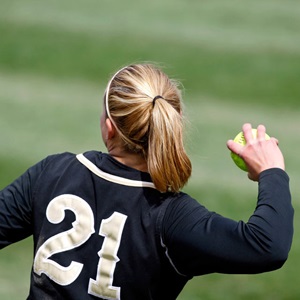
A SLAP tear can be a serious injury no matter your age or professional level. The majority of SLAP tears don’t happen in one day and usually result from repetitive trauma inside the shoulder.
Sports medicine specialist John Wilckens, M.D. explains the origin of SLAP tears and what players, parents and coaches can do to prevent this injury.
What are the results of surgery?
Generally most players can get back to their previous level of throwing, and it takes on average nine months for most players to be able to compete. Which type of rehabilitation in the first few weeks after surgery depends upon the type of procedure done, but by three months the player should have most of their range of motion back. A light throwing program can be started around four months, and it takes about three to four months to get all of the conditioning done to have the stamina to throw competitively.
There are not many scientific studies on the success of these operations. The more traditional operation, where an incision is made on the front of the shoulder, has been reported in the scientific literature. Two years after the surgery about 80 percent of players had returned to their previous level of throwing. What this means is that a majority of players get back to throwing, but even with surgery some may drop out of the game, sometimes for reasons other than their arm. However, we tell players that this operation will not make your arm bionic and it will not make up for poor mechanics. It takes hard work to recover from the surgery and there is a great chance that you can participate again.
The results for thermal capsular shifts have been reported at scientific meetings, but they have not been published in journals where the results can be scrutinized. Early reports suggest that the thermal shift does return a large percentage of players to throwing, but the exact percent is not known. The studies show that there are few complications with this operation, but the gold standard to which it is compared is the open procedure discussed above.
The current approach at Johns Hopkins
Since most cases of tendinitis of the shoulder resolve without surgery, it is important to try everything possible to prevent surgery. Also, the recovery from surgery is not short if the shoulder needs to be tightened up. A careful physical examination of the shoulder is important, and regular radiographs or X-rays of the shoulder should be done. If an MRI is done we recommend an arthrogram, where dye is placed in the joint prior to the MRI.
All of this information is processed to determine whether surgery is indicated. The level of competitiveness of the athlete and where they are in their careers are important considerations when determining if surgery is warranted. A player who is already established and making money from his shoulder is a different consideration than the player who is considering giving up the game anyway. The length of time for recovery is an important consideration as well, since surgery has to be timed to maximize recovery for when the season begins at the level of play the person is involved in at that time.
If surgery is necessary, we utilize a nerve block where the arm is made numb. Then we give a general anesthetic so that the player does not remember anything during the surgery. We first perform an arthroscopy and repair SLAP lesions through the arthroscope. If there is other damage that suggests the shoulder is loose, then we recommend an incision and an open operation. We feel that this procedure is indicated when there is more severe damage and feel that it is the gold standard for repairing loose ligaments.
If there is not so much damage in the shoulder at the time of surgery, then we have been using a thermal capsular shift procedure. While there are no published results on this technique, we think it is best for shoulders that do not have significant labrum or cartilage damage. We tend to use this operation more often in swimmers or volleyball players who have pain but not much damage in the joints.
The type of surgery to be done is controversial and currently there are several options. Each option should be carefully considered and discussed with your physician. The last factor to consider is the experience of the surgeon with each technique, as they may feel more comfortable with one procedure over another.

